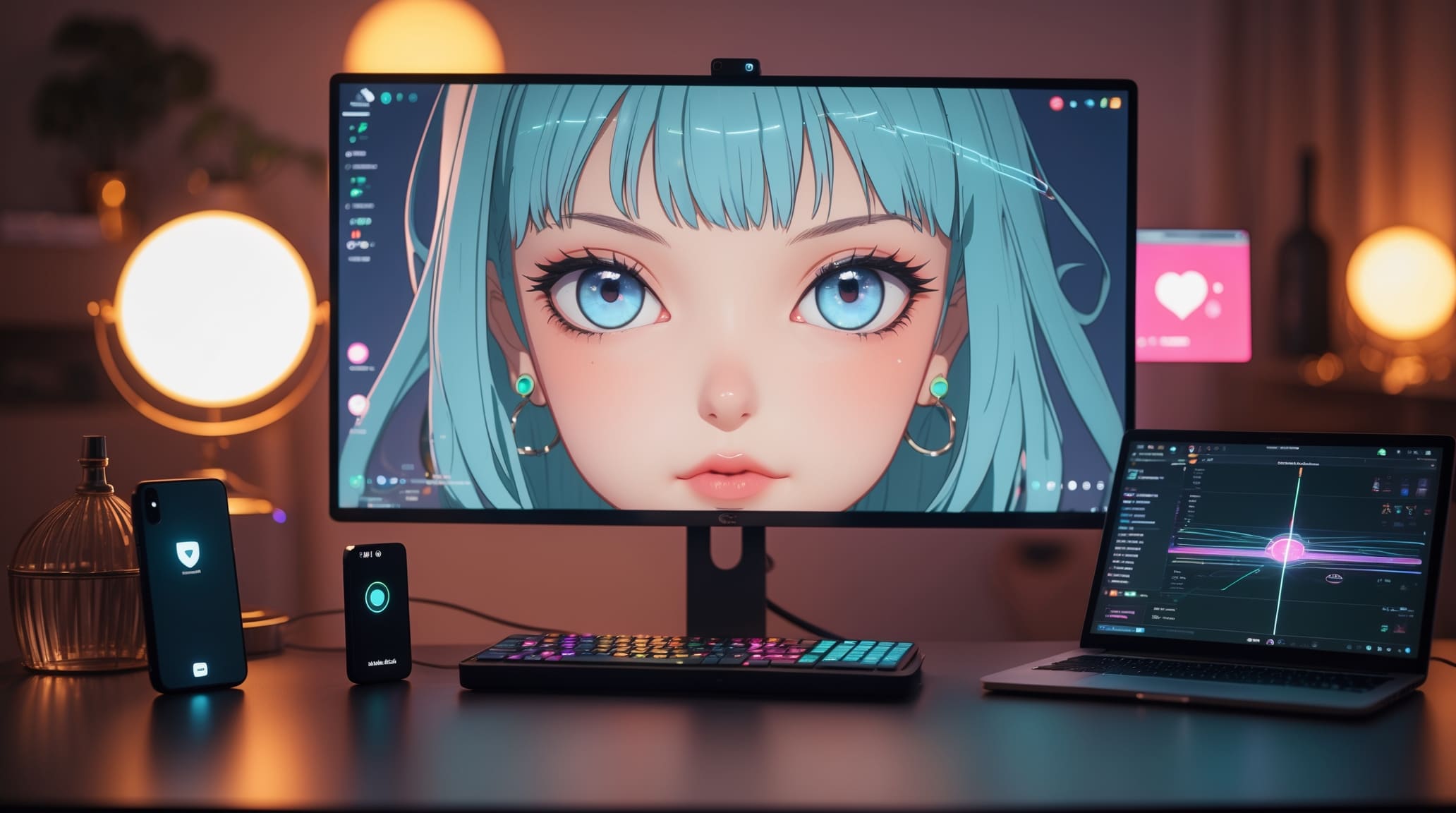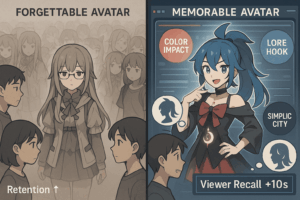Ever felt like a VTuber’s avatar just knew where to look? Like their gaze followed the moment, flickered with emotion, or locked in as if they were listening? That’s not just good art or luck, it’s the magic of VTuber eye tracking.
Gone are the days when blinking was the only trick avatars had up their sleeves. Today’s top VTuber models can mirror your gaze, shift focus, and respond to subtle emotional cues, all in real time. It’s subtle, yes. But it’s also transformative. This isn’t just about prettier streams—it’s about building presence. Let’s dive into how eye tracking evolved, why it matters more than ever in 2025, and what makes some models feel more alive than others.
What Is VTuber Eye Tracking?
At its core, VTuber eye tracking is the process of capturing and replicating a creator’s real-time eye movements within their virtual avatar. This involves more than just blinking; it includes subtle yet powerful motions such as gaze direction (looking left, right, up, down, or center), pupil movement and dilation in more advanced setups, and nuanced eyelid expressions like narrowing or widening the eyes.
When combined with facial tracking technology, eye tracking helps build a digital face that reflects the creator’s natural expressions in real time. This moment-by-moment replication brings a heightened sense of presence and realism to VTuber models, making interactions feel more immersive and emotionally engaging.
Tools That Make It Possible:
- Cameras: Regular webcams, iPhones with TrueDepth sensors, or dedicated eye-tracking hardware like Tobii Eye Tracker.
- Software: Platforms like VTube Studio, Luppet, Animaze, and 3tene translate your physical movement into virtual behavior.
- Avatars: High-quality VTuber models are rigged to accommodate naturalistic eye movement and subtle expressions.
Why Eye Movement Matters More Than You Think?
Many new VTubers assume voice or design is what makes an avatar feel authentic. But in practice? It’s often the eyes doing the heavy lifting.
Here’s why:
- Human Connection: Eye contact builds trust. Viewers are drawn to faces that “look back.”
- Emotional Expression: Emotions like surprise, joy, sarcasm, or confusion often show in the eyes before the mouth.
- Conversation Flow: In natural dialogue, we shift our gaze, glancing around while thinking or refocusing attention when we speak. Mimicking this is key for immersion.
The eyes silently guide the rhythm of interaction. When your avatar’s gaze responds naturally to speech, pauses, or chat activity, it creates a sense of real-time connection. This subtle responsiveness adds depth to performance and helps keep viewers emotionally engaged. If your model only blinks or stares forward, the illusion breaks. But with smart gaze detection, every glance adds to the illusion of life and keeps your audience watching longer.
How Eye Tracking Has Evolved in VTubing?
Let’s take a quick timeline of how we got here:
🕹️ 2018–2020: The Basics
- Avatars blinked or moved their eyes based on simple preset animations.
- Webcam-based software captured only face angles, and eye direction was usually guessed.
📱 2021–2023: The Apple Effect
- iPhones with TrueDepth cameras became popular among VTubers for high-accuracy face and eye capture.
- VTube Studio and others introduced built-in support for iOS-based tracking, revolutionizing Live2D model expression.
👁️ 2024–2025: Precision Era
- Advanced real-time eye tracking using AI (NVIDIA Broadcast, Tobii, Intel RealSense).
- Improved tracking accuracy, better mesh rigging, and more expressive avatars.
- Some models now even simulate emotional gaze shifts, looking down when sad, avoiding eye contact when flustered.
This leap has made VTuber models more responsive, more emotional, and more watchable.
What Makes Eye Tracking Feel Real?
Not all eye tracking is equal. For viewers to believe in your avatar, it needs more than just “functional” tracking—it needs emotional accuracy and behavioral believability.
1. Smooth Movement: Real eyes don’t snap from side to side. They glide. Good tracking tools use saccade smoothing to prevent jitter and simulate natural transitions.
2. Blinking That Reacts: Some setups blink on a loop. Others track when you naturally blink. The latter feels alive. Bonus: syncing blink rate with emotion (more blinks when nervous, fewer when focused) adds realism.
3. Gaze Targeting: Looking toward chat, the camera, or in-game elements based on your real-life focus? That’s gaze detection done right. It feels like the avatar is truly “in the moment.”
4. Emotion Blending: Advanced avatars link eye shape and gaze with emotional parameters. For example:
- Eyes slightly close when smiling.
- Pupils dilate when excited.
- Eyes widen in surprise.
These microexpressions build trust with viewers, even if they don’t consciously notice.
Eye Tracking in Practice: VTubers Doing It Right
Many VTubers today are using eye tracking to enhance not just their presence, but also their performance.
🎤 Shoto: Combines reactive eye contact with intense emotional storytelling. His model often shifts gaze naturally during conversation, making viewers feel directly addressed.
💀 Ironmouse: Her dynamic expressions, especially wide-eyed surprise and soft eye smiles, are driven by iPhone-based facial and eye tracking, layered onto a hyper-expressive Live2D model.
🐉 Kuzuha (Nijisanji): A 3D VTuber who uses full-body and eye tracking to reflect sharp, reactive humor. His eyes “cut” to the camera or collab partners in comedic timing.
These examples show how much performance eye tracking adds, not just visual fidelity, but emotional storytelling.
VTuber Eye Tracking Setup: From Starter to Pro (and What Powers It in 2025)
Whether you’re just starting or building a full-fledged streaming studio, your VTuber eye tracking setup can grow with you. From a simple webcam to pro-grade trackers, here’s what powers smooth, expressive avatars today—and how to choose what fits your needs best.
Beginner Setup: Just a Webcam, Big Results
Perfect if you’re just starting VTubing with a Live2D model and want a simple, budget-friendly setup that works out of the box.
- Hardware: Any decent webcam (1080p or better works well).
- Software: VTube Studio, Animaze, PrprLive (easy to use and beginner-friendly).
- Best for: New VTubers using Live2D models or those on a limited budget.
- Helpful Tips:
- Use soft, even lighting across your face to improve tracking accuracy and reduce false eye movements
- Position your webcam at eye level to avoid awkward or unnatural eye angles.
- Adjust the blink frequency and eye movement smoothness in the software settings to make your avatar feel more natural and less robotic.
💡 Many modern webcams now work surprisingly well thanks to AI enhancements like NVIDIA Broadcast and improved detection algorithms.
Intermediate Setup: iPhone with Face ID Sensors
A great middle-ground if you want smoother, more precise tracking using gear you might already have, your iPhone.
- Hardware: iPhone X or newer (with TrueDepth front camera).
- Software: VTube Studio (iOS version), iFacialMocap, Waidayo.
- Best for: VTubers wanting more accurate tracking without going fully pro.
- What You Get:
- Smooth and responsive eye tracking with excellent facial expression support.
- Works great for both Live2D and 3D models.
- Simple wireless setup, connect via Wi-Fi, and go live.
- Pro Tip: Always calibrate your gaze and blinking before you stream, especially after changes in lighting or scene transitions. This keeps your avatar’s eyes centered and avoids a “staring into space” look.
Advanced Setup: Professional Eye Trackers
Ideal for full-time VTubers, VR performers, and creators who want the highest level of realism and control in their streams.
- Hardware: Tobii Eye Tracker 5, Intel RealSense, HTC Vive Pro Eye (for VR rigs).
- Software: Luppet, 3tene, or custom Unity/VRM plugins for full-body setups.
- Best for: 3D VTubers, VR performers, or creators with high production goals.
- High-Level Features:
- Eye tracking zones: Program your avatar to look at specific targets like chat, camera, or in-game UI, based on where you’re actually looking.
- Emotional gaze triggers: Combine eye movement with facial expression triggers to create subtle, layered performances (like avoiding eye contact when shy).
- VR compatibility: Perfect for VTubers using full-body tracking or immersive 3D environments where precise eye focus matters.
This tier requires more setup time, but the payoff is a VTuber model that reacts almost identically to how you move in real life.
Common Mistakes (And How to Fix Them)
| ❌ Mistake | ✅ Fix |
| Avatar looks cross-eyed or unfocused | Recalibrate gaze axis and camera angle |
| Blink feels robotic or too fast | Adjust blink speed or switch to natural blink tracking |
| Eyes jump around unnaturally | Enable gaze smoothing in software |
| Emotion doesn’t reach the eyes | Blend eye movement with emotional parameters (like smile + eye curve) |
| Tracking works in setup, fails on stream | Always do a quick calibration check before going live |
How Eye Tracking Affects Engagement (With Real Results)?
Here’s what eye tracking can improve:
- Watch time: When an avatar feels expressive and alive, viewers are more likely to stay and watch longer. Subtle glances and blinks signal life, keeping the illusion intact and the audience invested.
- Chat interaction: Viewers are more likely to chat and respond when they feel “seen.” A quick look toward the screen when someone sends a message can feel like genuine recognition.
- Clipability: Spontaneous, natural eye reactions, like side-eyes, dramatic blinks, or widened surprise, turn into highly shareable and meme-worthy moments.
- Merch & Fanart: The more human and animated your avatar feels, the more fans want to draw, share, and support it. Expressive avatars generate emotional attachment that fuels creativity and loyalty.
In short, a creator who uses reactive eye movement builds presence, and presence builds community. It’s not just about tracking—it’s about making your virtual self feel human enough to form real emotional bonds with your audience. That emotional bond is what transforms passive viewers into active fans.
What’s Next in VTuber Eye Tracking?
As 2025 continues, VTuber eye tracking is rapidly advancing, and it’s not just about smoother animations. Developers are pushing boundaries with innovations that make avatars feel more alive and interactive than ever. To start, Predictive eye AI like NVIDIA Broadcast now fills in gaze direction when tracking drops, keeping your avatar’s eyes natural and immersive. At the same time, emotion-aware gaze tech analyzes your voice and adjusts eye movement to match your tone, adding subtle realism. Meanwhile, gaze-based interactivity lets you trigger scenes, sounds, or animations just by looking, bringing hands-free control to your streams.
Finally, emerging phygital integrations (currently in pre-launch) are worth watching closely. These systems combine digital eye tracking with wearable tech and physical gestures, creating a hybrid experience that blends real-world movement with virtual expression.
Final Thoughts
In vtubing, visuals matter, but presence is what keeps people watching. And nothing establishes presence like eye contact. Whether you’re reacting to chat, delivering emotional stories, or just vibing with your audience, smart eye tracking turns your model from a puppet into a performance. You don’t need a $1,000 setup to get started. Just a calibrated webcam, a well-rigged model, and the intention to make your gaze feel alive. Because in VTubing, how you look is important, but where you look? That’s what builds a real connection.



